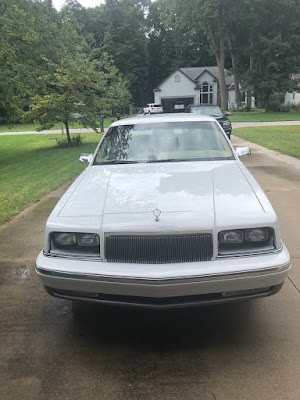Doesn't seem that long ago that my wife and I with were signing off on the purchase of a new Taurus and our very young sons were passing the time turning a brand new 2002 Ford Thunderbird, just like our little redhead here, into a jungle gym.
That Thunderbird the boys were pounding on beamed like a rock star to me and the young father I was at the time day dreamt wistfully about carefree days behind the wheel of one without a worry in the world. Funny how now that I could get one of these cars, on the cheap, of course, I want one as much as I'd want a typewriter. The hell happened?
Well, as I've gotten older, I've acquired the ability to at least attempt to see myself through other people's eyes. Especially with regards to the automobiles that I chose to drive. The car you drive does say a lot about you. For instance, that Ford Taurus my wife and I drove said - "steady, practical, family man". My daily driver at the time was a 1997 Chevrolet Monte Carlo LS which said similarly with a dash of pseudo-style. A 2002 retro futura Ford Thunderbird? What did this say about its owner? That I'm style and image conscious, that I'm not a car person (which is fine) and I spent a lot of money on something that makes me look older than I am.
From the get-go, these cars had a problem finding buyers not so much because they weren't great looking cars but because in addition to being niche, boutique automobiles, they were very expensive. At more than $40,000 each, and many dealerships marked these up when new north of $50,000, snow cones sold better to Eskimos. An overpriced, retro-styled, two passenger car - who'd buy that? Well, who do you think? Like I said, alta cockers.
A what? Us New Yorkers use the term "alta cocker", a Yiddish expression for "old man", to label anything we consider appealing to old people. In this case, oldsters attempting to seem young and/or youthful. Young, youthful and well-heeled too. Thing is though when grandma and granddad went to spend some of the money they'd will to their grandchildren, they had many better options than a tarted up Lincoln LS to choose from. And thirty or even twenty thirty-somethings had more compelling options as well; the throwback nature of the car may have been lost on them anyway. So, if they were not taken with what the car for what it was, they looked the other way. Ford certanily built a car here with a very narrow landing strip.
All that a shame seeing what stout performers these cars are. Based on the same chassis that underpinned the Jaguar S type, Lincoln LS and later, with some modification, the 2005 Ford Mustang, these cars could run circles around just about any other Ford Thunderbird that came out prior. Maybe not as fast as a 1989 Thunderbird Super Coupe but that 3.9 liter V-8 right there could provide enough poke that, with the top down, you'd better make sure your toupee's adhesive was fresh and secure.
Also, keep this in mind - retro-styled cars are not for everyone. To some, myself included, there's a cartoonish quality about them that I don't find appealing. These Thunderbirds and other "retros" like the Dodge Challenger, Chevrolet Camaro, Volkswagen new/old Beetle, Mini Cooper and even, to some degree, the current Ford Mustang are not "gotta have it" designs that transcend what inspired them. If anything, as far as I'm concerned, they make me want for a resto-modded original and not some modern facsimile. If you're not aware of the designs those cars are inspired by and like them for what they are then by all means then go for it. As for me, I'll stick with the originals. Mind you, not that I can afford them.































